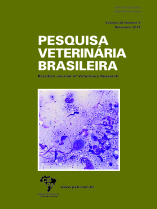 |
|
|
|
Year 2018 - Volume 38, Number 9
|

|
Lontra longicaudis infected with canine parvovirus and parasitized by Dioctophyma renale, 38(9):1844-1848
|
ABSTRACT.- Echenique J.V.Z., Soares M.P., Mascarenhas C.S., Bandarra P.M., Quadros P., Driemeier D. & Schild A.L. 2018. Lontra longicaudis infected with canine parvovirus and parasitized by Dioctophyma renale. [Lontra longicaudis de vida livre infectada por parvovirus canino e parasitada por Dioctophyma renale.] Pesquisa Veterinária Brasileira 38(9):1844-1848. Laboratório Regional de Diagnóstico, Faculdade de Veterinária, Universidade Federal de Pelotas, Campus Capão do Leão, Pelotas, RS 96010-900, Brazil. E-mail: alschild@terra.com.br
This study describes a case of parvovirus infection in a river otter (Lontra longicaudis) assisted at the Wildlife Rehabilitation Center and Wildlife Screening Center, Federal University of Pelotas (UFPel), Rio Grande do Sul state, Brazil. Clinical signs included apathy, dark and fetid diarrhea, and crusted lesions on the palmar pads of the fore and hind limbs. The animal died after undergoing support treatment with antibiotics, anti-inflammatory, and fluid therapy. At necropsy, the intestines were reddened and edematous and the right kidney was diminished by one third of its normal size and covered with whitish, spongy material. A female Dioctophyma renale was found free in the abdominal cavity. Histologically, dilatation of the intestinal crypts and fusion and blunting of the intestinal villi were observed. In addition, moderate, multifocal lymphocytic enteritis with lymphoid depletion in Peyer’s patches and mesenteric lymph nodes were present. Immunohistochemistry with anti-canine parvovirus monoclonal antibody (anti-CPV) was strongly positive in the bone marrow cells and enterocytes of the intestinal crypts, confirming the diagnosis of parvovirus infection. The peritoneum on the right kidney was expanded with a cuboidal cell border, forming multiple papillary projections associated with eggs of D. renale and severe inflammatory infiltrate (giant cells, macrophages, lymphocytes, eosinophils, and plasma cells). Areas of necrosis and mineralization were also observed. Due to fragmentation and degradation of its natural habitat, the otter approached the urban area and was contaminated with the virus, which is hosted and disseminated by domestic animals. Infection with D. renale can be associated with the large population of parasitized domestic animals, which eliminate the helminth eggs through urine, contaminating the environment where the parasite intermediate and paratenic hosts co-inhabit. The diseases of these animals can be a decline factor of wild populations that inhabit the region and are an alert to spillover risk. |
| |
|
|
| |
|
 |